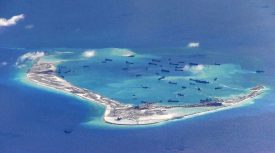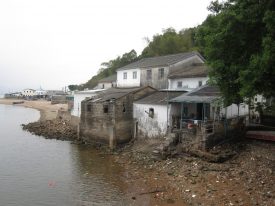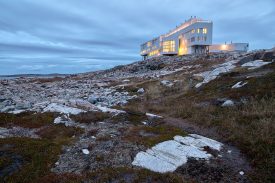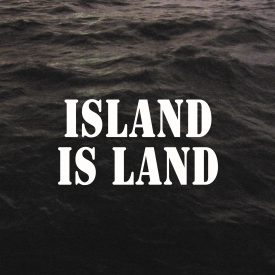Our Future IsLand
By Sallie Lau

If someone asked you to draw the ocean, what would you draw?
“Probably a horizontal line,” says Valerie Portefaix, an artist who looks at physical and imaginary territories and how humans subvert and appropriate them. “I don’t think people see the ocean as a 3D space. They just see it as a 2D blue surface that creates distance.”
In our conversation, Portefaix mentions distance to explain how people think of the ocean as a spatial barrier between a point A and some point B. But I think her perspective reveals another exemplification of distance: our self-inflicted removal from the ocean. After all, the only time the ocean resembles a line is when the horizon is looked at from very far away. Now that the majority of people live in cities, being very far away means viewing the world from a window on the 89th floor of a skyscraper or meandering along hardened shorelines built on top of reclaimed land. This urban armor protects us from seeing the intended protection the ocean offered us—food sources from the shoreline like oysters and seaweed protect us from going hungry, marine ecosystems like coral reefs protect us from floods.
Being on land and forging our own armor out of the city, it is hard to see depth of the ocean. I come from a background of creative writing, and we talk a lot about giving depth to characters: backstories, desires, messy thoughts, flaws—these details are the elements that make us empathize with people who don’t exist. They turn an idea into someone real and tangibly felt.

When we can’t fathom the person within a character, we fail to empathize with them. Likewise, a lack of understanding of place leads to a lack of empathy for place. We dredge seabeds and trawl for polymetallic nodules and already depleted fish populations. We displace the livelihoods of peoples through our inequitable fisheries allocation decisions and our callous designation of marine protected areas. Without empathy of place, we fail to give depth to our character, the ocean. The ocean becomes one-dimensional: the next frontier for exploitation and opportunity.
So how can we empathize with, or even begin to relate to, the ocean? Portefaix speculates that the answer lies in how we treat islands as a society. She and Laurent Gutierrez, her partner on the multidisciplinary platform MAP Office, have been exploring the meanings and metaphors of islands through their art for a large part of their careers. Historically, islands have been used as jails, platforms where nuclear weapons were tested, and hidden military bases. More recently, islands have been used as discreet corporate fiscal refuges during the economic crisis of 2008 and as “out-of-sight-out-of-mind” military bases. Islands are just small specks of land in the oceans, but the we use them for very specific and often important human-centric activities. These activities are secrets that their keepers feel are best kept hidden from the world by islands.

Perhaps it is this tactful act of concealing secretive affairs that makes islands invisible. Coincidentally, local economies and ecologies that develop on and around islands are also veiled away from sight and out of reach. These island economies and ecologies hold a kind of specificity to them that does not conform to the way we frame urban society, and this notion of being “far away” evokes a sense of isolation when you are an outsider peering in. It might be isolating to the point where you no longer want to look in. Hong Kong, a place Portefaix and I both call home, has around 260 islands within its waters, but she estimates that out of these 260 islands, most urban citizens can only name six or seven.

Fluid and resilient by design, islands provide a way of life that is non-compliant with that of urbanized areas. Portefaix believes islands have become examples from which we will learn to forge an alternative relationship with the ocean. On Fogo Island, off the northeast coast of Newfoundland, Canadian artists, businesses, and communities, among others, are coming together to redefine their relationships with the sea and to rejuvenate its maritime economy. On the man-made, floating village of Sandu Ao, China, community members continue to participate in an economy of self-sustenance as they harvest and preserve seaweed and abalone for trade, their self-made island a form of resistance to the urban development that surrounds them.

That is not to say that we should all move to islands and re-examine our big-city ways of life, even though the thought may be appealing for some. What is important, according to Portefaix, is to uncover an understanding of the values embedded within these invisible island communities that have been transmitted between generations. With the reliance on intergenerational knowledge, however, comes the risk of island communities disappearing due to an aging population and young people’s increasing disinterest in continuing those ways of life. It is crucial, then, to stitch together and give recognition to the various art forms and practices, such as recipes, methods of farming and processing, and ways of collaboration, that have made these systems so resilient. As Portefaix puts it, we would be creating a cultural seed bank, in a way: “we are trying to collect the seeds of what is going to be lost very soon.” But what is the point of only collecting seeds? As more and more people migrate into coastal cities, it is important that we look at these island values — we must not hesitate to collect and plant the seeds. And as we move forward as a global community, we must also begin to ponder ways to adopt them into a non-island context— we must think about how to nurture the seeds to sprout and eventually, to bloom.
